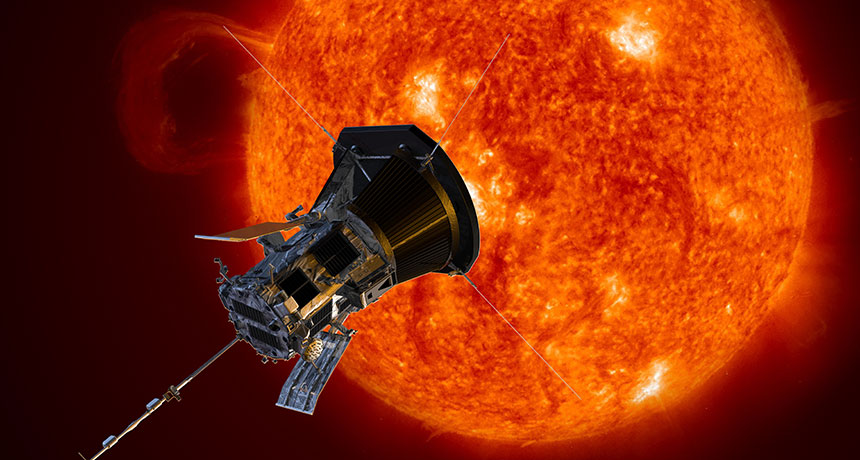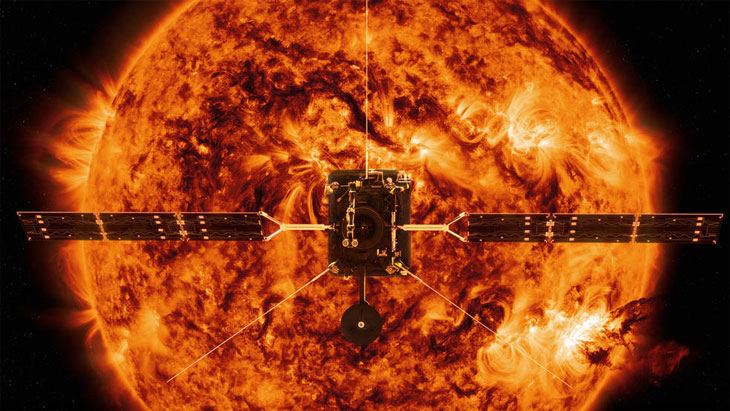NASA’s Parker probe is about to get up close and personal with the sun
The spacecraft, set to launch August 4, will get within 6 million kilometers of our star

SUNKISSED The Parker Solar Probe (illustrated), set to launch in early August, will get closer to the sun than any previous spacecraft.
JHU-APL
- More than 2 years ago
NASA’s Parker Solar Probe is about to embark on one daredevil stunt of a space mission.
Slated to launch August 4, the probe will be the first spacecraft to swoop through the sun’s outer atmosphere, or corona, a roiling inferno of plasma heated to several million degrees Celsius.
Parker will whip around the sun two dozen times over the next seven years, skirting within about 6 million kilometers of the star’s surface — more than seven times as close as any previous spacecraft. At its nearest approach, Parker will hurtle through the corona at about 700,000 kilometers per hour, making the craft the fastest human-made object in the solar system. The probe would need only about a second to zip from Philadelphia to Washington, D.C.
Parker’s closeup observations of the corona and the solar wind, the torrent of charged particles that the sun spews into space, could help resolve long-standing mysteries about the inner workings of the sun’s atmosphere. And the new data may improve forecasts for space weather that endangers spacecraft, astronauts and technology on the ground.
The trove of new data gathered by this probe “is going to answer a lot of questions that we couldn’t answer in any other way,” says Craig DeForest, a heliophysicist at the Southwest Research Institute in Boulder, Colo., who is not involved in the mission. “There’s been a tremendous amount of anticipation.”
IN THE THICK OF IT This view of the sun, as seen the by a coronagraph onboard the Solar and Heliospheric Observatory spacecraft, reveals the turbulent structure of the sun’s outer atmosphere, or corona. Parker will be the first probe to soar through this searing plasma. |
Scientists have had a probe like Parker on their mission wish lists for nearly 60 years. In 1958, the year that NASA was created, the National Academies’ Space Studies Board recommended that the new agency send a spacecraft inside the orbit of Mercury to investigate the environment surrounding the sun.
Over the years, several research groups have floated solar probe mission ideas, but none could get as close to the sun as astronomers wanted. “It’s only been recently that the technology of heat shields and everything else has converged well enough that we could make this a reality,” DeForest says.
About the size of a small car, the Parker Solar Probe will pack instruments to take 3-D images, measure electric and magnetic fields and catalog high-energy particles. Although the corona sizzles at millions of degrees, the atmosphere is so diffuse that most of the heat that will imperil Parker’s instruments comes from radiation emanating directly from the sun’s surface. This lethally intense sunlight can heat the face of the spacecraft to about 1370°.
To guard Parker’s instruments against that radiation, the probe is armed with a heat shield composed of a layer of carbon foam sandwiched between panes of another carbon-based material similar to the graphite epoxy used to make golf clubs and tennis rackets. As Parker swings around the sun, this heat shield will continuously face the star to keep the instruments tucked behind it safe from radiation up to about 475 times as intense as what Earth-orbiting spacecraft endure.
Parker will dive into the sun’s corona for the first time just three months after launch, sending its first batch of data back to Earth in early December. For scientists, that’s pretty quick gratification: For spacecraft such as New Horizons (SN Online: 6/15/15) that have rendezvoused with more distant solar system objects, the intermission between launch and arrival can span years.
The probe will circle the sun 24 times, using Venus’ gravitational pull to gradually shrink the craft’s orbit. On its first go-round, Parker will fly to about 24 million kilometers from the sun’s surface; on its final few loops in 2024 and 2025, the probe will get within about 6 million kilometers.
ROUND AND ROUND The Parker probe will circle the sun 24 times over the next seven years, using the gravitational tug of Venus to gradually shrink its own orbit. On its first go-round, Parker will get as close as 24 million kilometers to the surface of the star. On its final few loops, beginning in 2024, the probe will skirt within about 6 million kilometers of the sun’s surface. |
The probe may have some fuel left over to keep cruising around the sun after completing its mission-mandated 24 orbits, says Nicola Fox, project scientist for the mission. But eventually, Parker won’t be able to fire the thrusters that it needs to keep its heat shield aimed at the sun. The probe “will start to turn, and bits of the spacecraft that are totally not designed to see the sun will be in full illumination,” says Fox, a heliophysicist at the Johns Hopkins Applied Physics Laboratory in Laurel, Md. “The spacecraft will break up into kind of large chunks at first, and then they’ll get smaller and smaller.” Eventually, Parker will be nothing more than a smattering of dust scattered across the corona.
The spacecraft’s legacy, however, will live on. Parker’s observations are expected to help answer questions about the corona and solar wind that researchers have puzzled over for decades.
For instance, Parker data could explain the strange temperature difference between the surface of the sun, which is a toasty 5500°, and the several-million-degree corona. This spike may be due to vibrating magnetic field lines heating up material in the corona, or jets of material from the sun’s surface that inject energy into its atmosphere (SN Online: 8/20/17). Parker could also help explain where solar wind particles get the energy to speed up as they escape the sun’s immense gravitational pull (SN Online: 8/18/17).
The enigmatic coronal heat and acceleration of the solar wind probably have a common cause, says David McComas, a space plasma physicist at Princeton University. McComas is the principal investigator for one of the probe’s instruments, the Integrated Science Investigation of the Sun. There are many competing theories to explain these two problems, but Parker’s views of the sun should help winnow down the list of possible explanations.
Parker’s observations should also give new insight into the origins of those highly energetic particles that escape the sun into the solar wind, McComas says. The solar wind washes over Earth at hundreds of kilometers per second, and disturbances in this cosmic breeze can mess with satellites, spacecraft and power grids (SN: 8/19/06, p. 120). A better understanding of the sun’s tumultuous atmosphere and solar wind could lead to better forecasts for potentially dangerous space weather events.
On top of all that, Parker’s zoomed-in view of the sun will undoubtedly raise new mysteries about our home star, McComas says. The data haul from “one mission [often] just whets our appetites for even more observations down the road,” he says.
Fortunately, another spacecraft bound for the sun is launching right on the heels of the Parker probe. The European Space Agency’s Solar Orbiter, set to take flight in 2020, will provide the first direct images of the sun’s poles. Paired with Parker’s observations closer to the sun’s midriff, Solar Orbiter data may reveal how the solar wind varies at different latitudes.

These missions aren’t just about getting to know our own solar system. “Once you know about how our star works, you’re going to know a lot more about … other stars,” Fox says.
Whatever scientific discoveries come from the mission, it’s difficult not to get excited for the sheer “wow” factor of the probe’s impending expedition. “This is really freaking cool,” DeForest says. “We’re launching a probe and flying it through [several-] million-degree plasma on the periphery of a star. I mean, how cool is that?”







